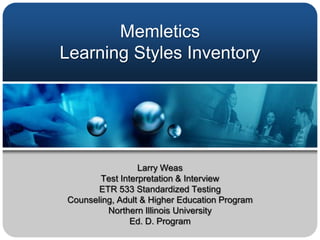
Memletics Learning Styles Inventory
- 1. Memletics Learning Styles Inventory Larry Weas Test Interpretation & Interview ETR 533 Standardized Testing Counseling, Adult & Higher Education Program Northern Illinois University Ed. D. Program
- 2. Introduction Instrument: Memletics Learning Styles Inventory Date:Administered Instrument: March 2, 2011 Interview: March 28, 2011 (30 minutes) Client X:Occupation: Dental Laboratory Technician & Property Owner Gender: Female Race: White Caucasian Age: 53 Experience: 20+ years in the workforce Hometown: Elizabethtown, Kentucky Interest:How her preferred learning styles can be better matched and used in different learning situations, whether at work or at home. Instruments: Nikon Digital Camera with HD Video Recording Roxio Creator 2011 PRO Digital Media Authorware
- 4. Remember about the Assessment
- 5. Purpose of the Inventory
- 8. Part Two: Interview Session
- 9. How the Instrument Measured the Seven Learning Styles
- 10. Meaning of the Learning Styles Web-Graph Scales
- 11. Review Pre-Test and Post-Test Results
- 12. Integrate Assessment with Client’s Learning Styles
- 13. Self-Directed and Social Learning Styles
- 14. Learning Styles and Using Technology
- 15. Future Education and Job Skills
- 19. Recognize Client’s Results and Participation
- 21. Reasoning & Why I Chose? The Memletics Accelerated Learning System recognizes that each person prefers different learning styles and techniques. Learning styles group common ways that people learn. Everyone has a mix of learning styles. Some people may find that they have a dominant style of learning, with far less of other styles. Others may find that they use different styles in different circumstances. There is no right mix. Nor is your style fixed. You can develop ability in less dominant styles, as well as further develop styles that you already use as well. Learning Styles Inventory
- 23. It gives a clear structure and specific steps to help one achieve top mental fitness and highly effective learning practices from using their dominant learning style.
- 24. It recognizes the brain's natural abilities and uses effectively. The brain has an immense capability for learning, and Memletics helps a person use more of their unused capability.
- 25. It recognizes both a physical and mental perspective with learning styles. With some knowledge of what positively and negatively affects the brain.
- 28. “1”– The description sounds partly like you.
- 29. “2”– The description sounds exactly like you.Instrument Pre-Test: After reviewing each of the basic descriptions for each axis, Susan estimated on a rating scale of zero to twenty if she uses that style often. A score of twenty if mostly used and a zero if hardly used. Questionnaire. Next, each of the seventy questions was answered by circling one of the numbers on the right for each question read from the inventory. The following rating scale responses for each question answered were as follows: “0” – The description sounds nothing like you. “1” – The description sounds partly like you. “2” – The description sounds exactly like you. Post-Test: Graph her scores on the blank web graph sheet just as she had done with the pre-test before answering the seventy-questionnaire.
- 30. Learning Style Results Client X: Pre-Test Results
- 31. Learning Style Results Client X: Post-Test Results
- 32. Overlap of the Two Client X: Pre-Test & Post-Test Results Pre-Test (Blue) Post-Test (Red)
- 33. Comparison of Learning Styles Client X: Learning Style Results for the Interview Pre-Test (Blue) Learning Style Zone Post-Test (Red)
- 34. Client’s Findings Highest Score (Social) Post-Test Score (Dominant – Upper) Lowest Score (Logical & Solitary: Tie) Pre-Test Score (Dominant – Lower)
- 36. Learning styles differ with different situations?
- 37. Identifying and knowing her Learning Styles?
- 38. Did you see value?
- 39. Learning styles correlate with the Seven Learning Styles Inventory?
- 40. Integrating information and learning with other Information?
- 41. The Use of Technology?
- 43. Learning with other Age Groups or peers?
- 44. Role as a Learner ?Memletics Learning Styles Inventory Interview
- 45. Reflecting on the Interview The learning styles inventory consists of recognizing pre- and post-test responses from seven particular learning style groups preferred is as follows: Logical: Surprised! Much more logical and systematic in her learning. Visual: Blended: Goes along with her physical requirements on the job. Social: Dominant: Most highly desirable with groups or someone else. Physical: Work: Job requires handling, designing, building dentures. Aural: Least: Boring to just listen to someone. (OSHA safety tapes) Verbal: Reading alone isn’t preferred she likes blended. Solitary: Most challenging for her without someone.
- 47. Was the Memletics Learning Styles Inventory Valid?
- 48. Was the context in identifying the client's learning styles Reliable?
- 50. However, some interesting points to consider:
- 51. Learning Environment: (Work, Home, and Academia)
- 52. Multi-Generational Audience: (Baby Boomers, Generation X-Y, and Millennials)
- 53. Using other Learning Style Inventories: (Different Models)
- 54. Dominant vs. Secondary Learning Styles: (Everyone Learns Different)